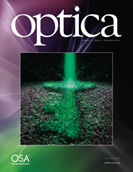Adaptive Quantum Optics (AQO) combines adaptive methods to counteract or even exploit disorder in nanophotonic systems in combination with quantum states of light. Adaptive systems can compensate for fluctuations and inevitable randomness in nanophotonic structures. Examples of such structures are natural or artificial multiple-scattering photonic media or engineered nanophotonic structures. By employing integrated photonic networks or spatial light modulators, we control the path of single photons through a nanophotonic system, thereby realizing quantum transport through photonic networks. The propagation of single photons through such a network is extremely hard to predict classically. For this reason, these platforms are promising for achieving a quantum advantage in certain computational tasks. Complex photonic media also turn out to have intricate applications as physical unclonable keys which we study and develop further.
Research area
Quantum optics is a field of research that investigates the interaction between light and matter on the fundamental level of single atoms and single particles of light, photons. Experiments in this research area typically exploit carefully controlled photonic environments, where light “lives” in single or at most two or three channels and where losses and disorder are carefully avoided. Multiple light scattering is in some sense the complete opposite: it is the process that we know from white materials such as milk or clouds, where light scatters thousands of times and is easily lost in an unobserved direction or absorbed. Therefore, the combination of quantum optics and multiple light scattering seems unusual. Intriguingly, however, modern spatial light modulators such as the chips that form images in video projectors allow to reconfigure hundreds of thousands of spatial channels, and recombine them to only a few. Hence, quantum properties can be exploited, not by traditionally reducing the number of photons down to unity, but having the number of channels by far exceed the number of photons. This new very-high-dimensional quantum regime allows new applications in security that are much closer to real-world devices than traditional quantum optics, since it is a more robust way to enter the quantum domain. AQO is one of the few groups worldwide working at the border between quantum optics, nanooptics and security. It has a state-of-the-art heralded single photon source, complex light scattering equipment, and single-photon sensitive detectors.
With the arrival of Dr Renema, a new chapter is added to AQO, namely that of Quantum Information Processing with photonic chips, state-of-the-art SPDC sources and superconducting single-photon detectors.
Physical unclonable keys (PI: Pinkse)
Modern society strongly relies on authentication methods to provide trust in transactions. Authentication typically relies on “what you know, what you have or what you are”, that is, a code key, a physical key, or a biometric signature. While code keys must be kept secret, most physical keys and biometric signatures can be copied. In contrast, Quantum Secure Authentication (QSA) is secure against copying of the key because it uses a key consisting of billions of randomly organized nanoparticles that is impossible to copy with existing technology. QSA is secure against imitating the key with alternative means by virtue of quantum physics: while the illumination pattern of the readout contains only a small number of photons, it is impossible for an attacker to determine the pattern. Therefore, he cannot generate the correct response. QSA is secure even when attackers obtain all possible information about the key. Moreover, QSA only involves proven mathematical assumptions and is relatively straightforward to implement; we have obtained a patent on the invention and are exploring applications of QSA in high-security access systems and banking.

Quantum Secure Authentication featured on the cover of the December 2014 issue of Optica, the flagship magazine of the Optical Society (OSA).
boson sampling (pi: renema)
Light propagates almost instantaneously through a linear photonic network. This also holds for a set of single photons distributed over a few input modes of the network: they come out with the speed of light. However, the distribution with which they come out becomes classically intractable if the number of single photons surpasses a few dozen. It is therefore believed that the propagation of single photons through such a linear network is one of the prime candidates for an experimental proof of reaching a quantum advantage with quantum light for a computational task.
Photonic simulations (pi: Klärs)
Our research team investigates physical phenomena at the interface between thermodynamics and quantum mechanics in optical and optomechanical systems. Our current research projects are optical spin glass simulation for the solution of mathematical optimization problems, condensation phenomena in light, and non-equilibrium thermodynamics. For more information about this research, please visit: https://photonicsimulations.group
